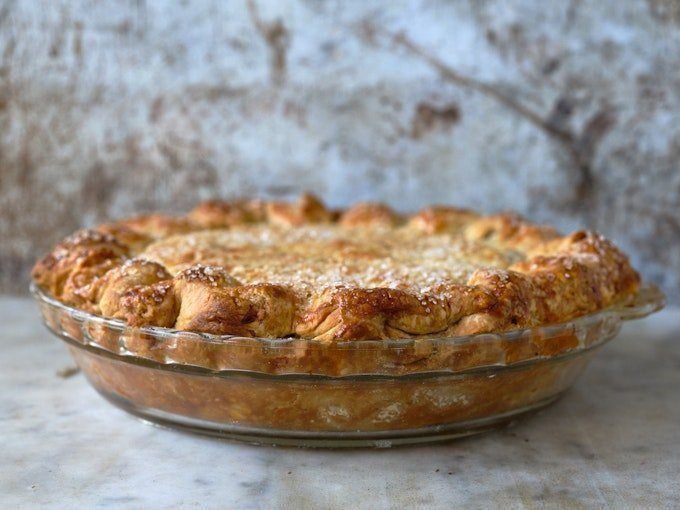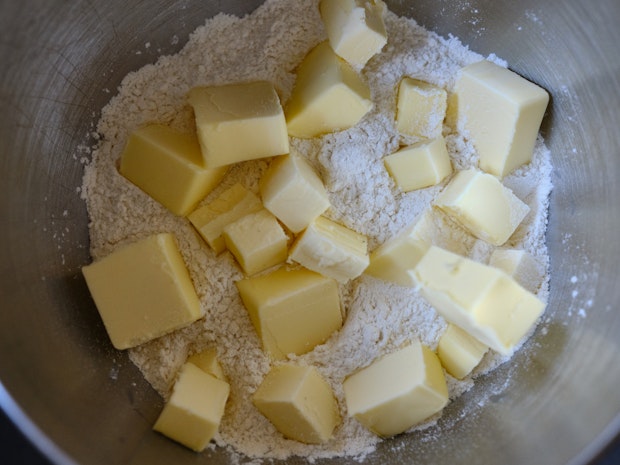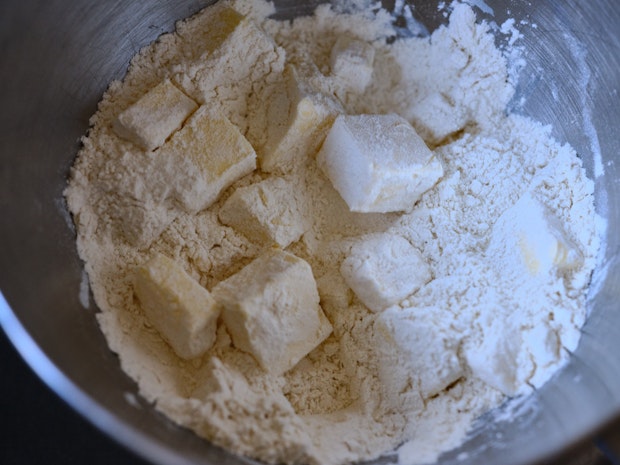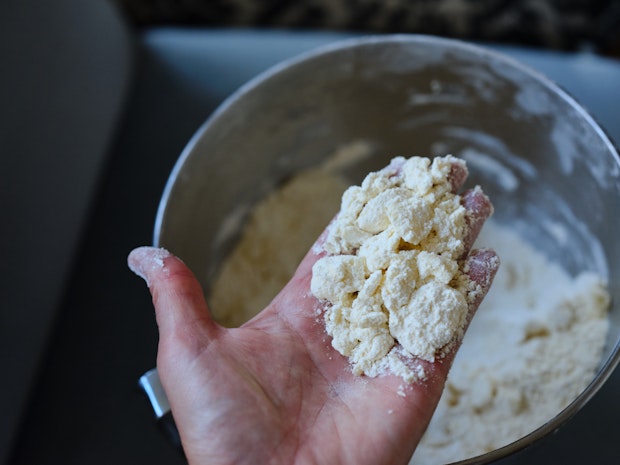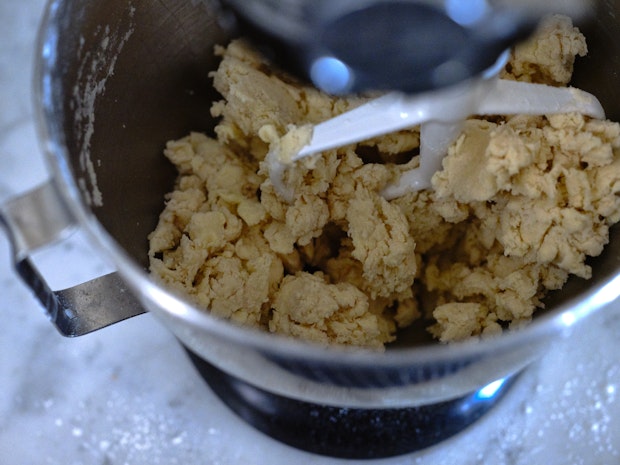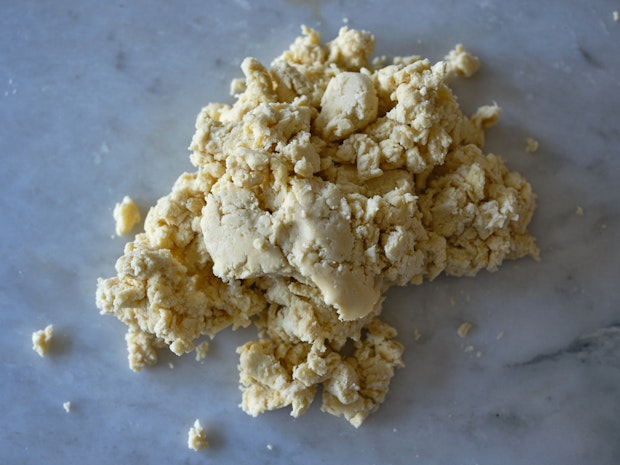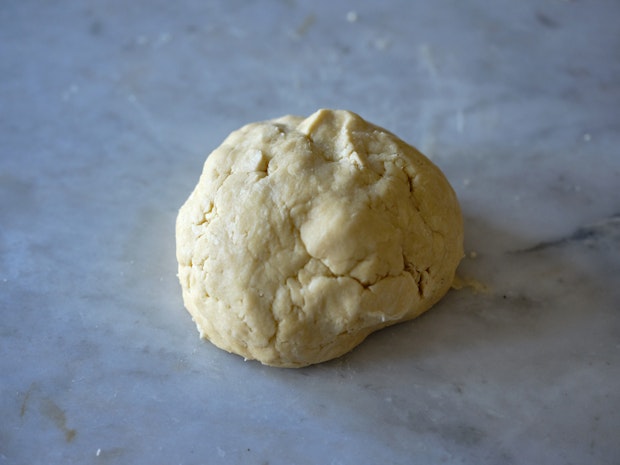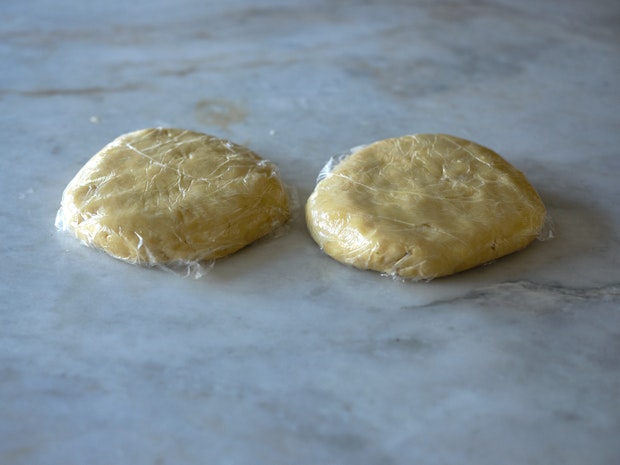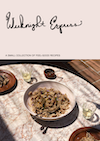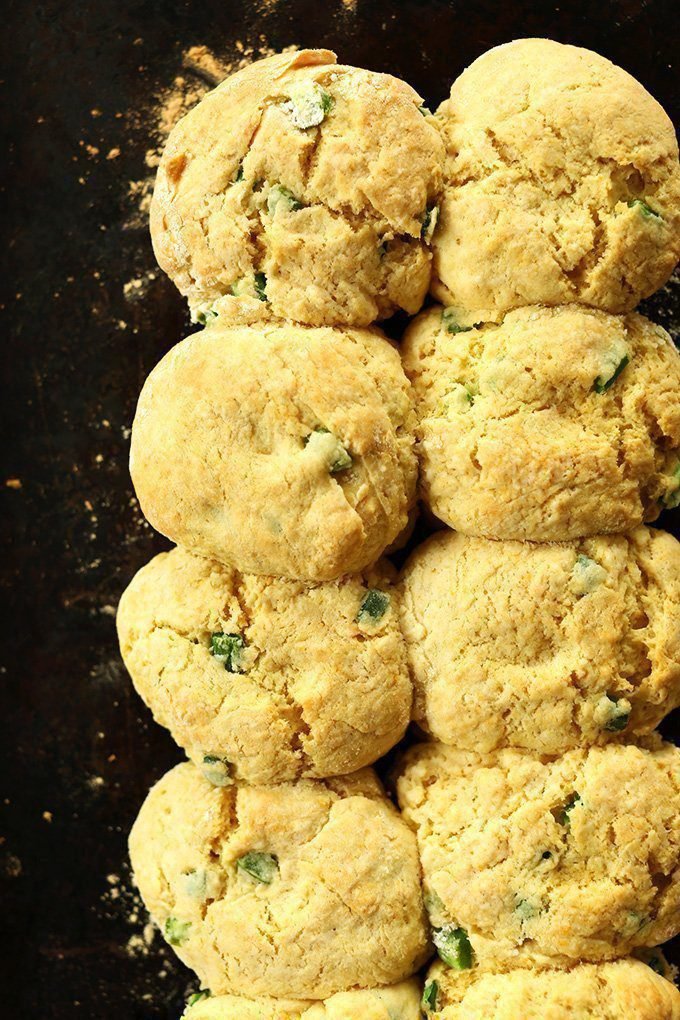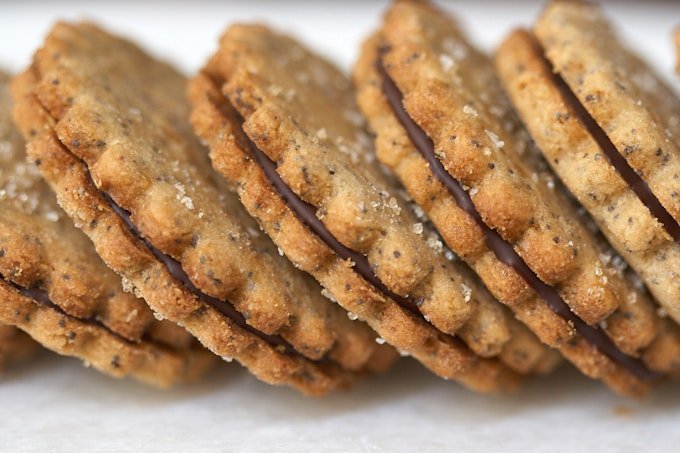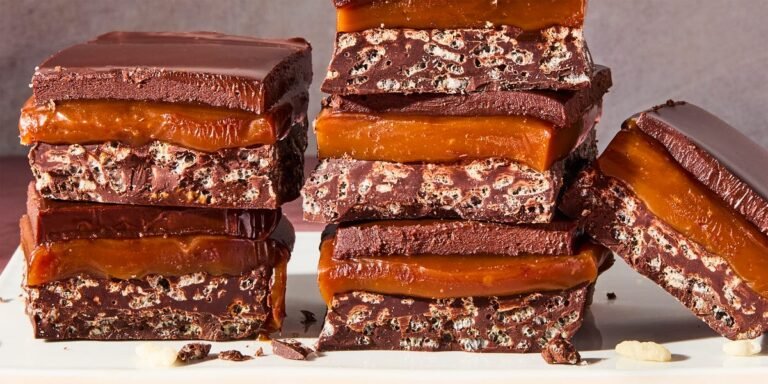As an Amazon Associate, I earn from qualifying purchases.
For a long time I used a different method for making pie dough than the one I’m going to share today. The process was all by hand, there was a lot of smearing and folding, and it was great – beautiful pie crust every time. This was in San Francisco where my kitchen tended to stay quite chilly. Summer temperatures rarely cracked 60°F. It was a pie makers dream – cold marble countertops year round.
I’ve had to switch up my game since living in Los Angeles. My kitchen is always too warm, and when it comes to pies, I was struggling a bit. I’ve since realized the less I touch the pie dough in the process of making it, the better. So, here we are. This is my go-to pie crust these days. It’s a mash-up of everything I’ve learned about pie dough over the years and delivers a beautifully golden, super flaky, all-butter pie crust. It’s easy to make, I use my electric mixer with the paddle attachment to smear butter into flour quickly, and it makes less of a mess than doing it all on a countertop (which I still love to do on occasion).

Pie Dough: Details & Inspiration
My goal in this post is to provide you with direction that will result in you feeling more confident making pie dough and beautiful pie crusts. Or, if you already feel confident, perhaps you’ll learn a new technique. Every cook needs a great go-to pie dough recipe, one you love and can use across a wide range of pies in your life. For a long time, and while living in San Francisco I often used Pim’s One Pie Dough To Rule Them All, inspired by Judy Rodgers and the The Zuni Cafe cookbook. I still love this dough. For many years, I used it as a jumping off point, often playing around with different types of flour ratios, introducing rye flour, or farro flour, or semolina. If you want to make a beautiful pie crust 100% by hand and have a bit of time for the fold and chill series – this recipe and technique will do you right. It disappears from the internet now and then, but seems to be here pretty reliably.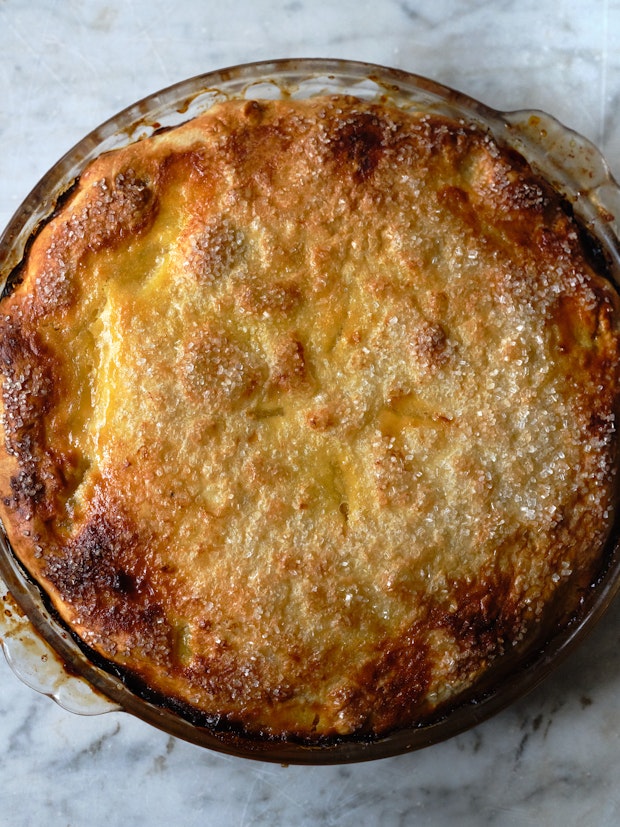
When I came to Los Angeles, I met Nicole Rucker. She’s a force. She’s queen of the pie scene (and so much more!) and her pies are everything I want – technicolor flavor, juicy and bubbly, with shatteringly flaky, rustic, butter crusts. And so golden. The color of her crusts are swoon-worthy. She wrote a book in 2019 (Dappled: Baking Recipes for Fruit Lovers) and her approach to pie crusts caught my attention. There were two techniques that Nicole used that were unusual. She added a bit of vinegar to her pie dough. She also diluted her sugar into a hot water and vinegar solution, chilled it, and proceeded with the dough from there. Here’s what she says:”the addition of vinegar adds a layer of tenderizing magic that shortens the production of gluten strands.” And by incorporating the vinegar into the hot sugar mixture, you’re creating a syrup that thoroughly permeates the dough. Double win.
In Dappled, Nicole has you make her pie dough on a counter top. It tends to be so warm where I am, and we rarely use air-conditioning, so I’ve been incorporating Nicole’s wet sugar and vinegar move, but use my electric mixer with the paddle attachment to make quick work of things. To be honest, I haven’t looked back. The paddle attachment does a fine job of smearing the chunks of butter into the side of the bowl. I drizzle just enough icy liquid into the flour and butter, as the mixer is running, and everything quickly comes together. Then just a quick shape, wrap, and chill before it’s all set to roll out and assemble the pie. The recipe and technique included below is my current gold standard. It’s unfussy, contains the kitchen mess to one bowl, and delivers a banger of a pie crust. I’ll break it down into basics.
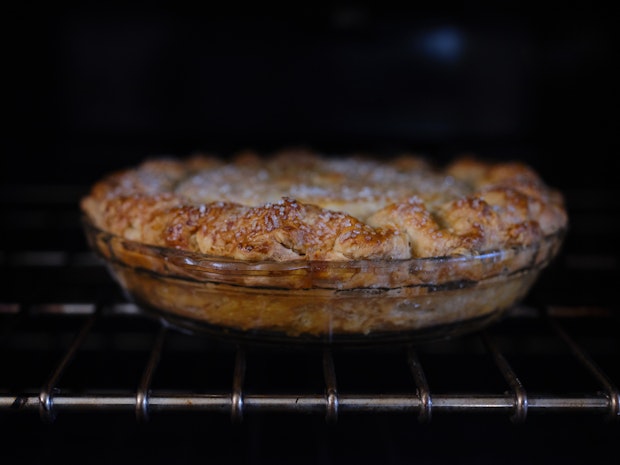
Electric Mixer vs. Food Processor for Pie Crusts
A lot of people use a food processor to cut the butter into the flour in their pie dough. It actually does a great job of this. That said, I like to use the stand mixer better. I feel like it is gentler and better mimics the motions of making pie dough by hand. The electric stand mixer smears and tumbles the flour and butter, it isn’t cutting and slashing the way a food processor does. And because of this it seems to leave more long thin pockets of butter in the dough as you roll it out resulting in a tender, shard-y crust that crackles as you slice into it.
Basic Pie Crust Steps
- Mix sugar, vinegar, and salt into hot water and chill.

- Smear butter cubes into flour using electric mixer with paddle attachment.


- Slowly drizzle chilled water mixture into dough until it comes together.


- Mold pie dough into ball.

- Cut in half. This recipe yield two 9-inch crusts.

- Flatten into discs and wrap in plastic wrap.
- Chill for 2 hours before using.
What type of vinegar to use in pie crust?
The short answer is: one that tastes good. I’m including a list of vinegars I tend to reach for when I’m making crusts like this. Most often it’s a great tasting white wine vinegar, but I like to play around.
- Apple cider vinegar: Reliably good, apple cider vinegar is something a lot of people keep on hand, and it works well in pie dough.
- Katz Late Harvest Sauvignon Blanc Vinegar (agro-dolce) 5.5% acidity: first choice for pie crust related vinegar in my kitchen.
- Camino Red Wine Vinegar: I don’t always grab this one for pie crusts, but I have, and you should grab a bottle if you can. It’s wonderful, and makes everything it touches more wonderful. You should just know about it in general.
- TART Lavender Vinegar: For a whisper of lavender in your crust this is the way to go. Or to reinforce lavender notes in your filling. For example, I baked a Shaker lemon pie using TART Lavender Vinegar in the crust, while also allowing the lemons to macerate alongside a bit of lavender. Just long enough for the flavor to develop nicely. Removed the lavender spring and baked.
- Brightland Parasol: I love the citrus notes in this one. It’s a vinegar fermented with chardonnay grapes and Valencia and Navel oranges, 5% acidity.
How To Roll Out Pie Dough
Let’s just walk it though here step-by-step. After the pie dough has chilled for two hours, it is time to roll it out. Lightly flour the your counter, rolling pin, and your hands. If at any point in the process the dough is sticking, dust with more flour. Start from the center of the dough and roll out in all directions, turning the dough regularly as you go. Roll the dough a couple inches larger than your pie dish. I’ve found that if you start having cracks and fissures at the edges of your dough as you’re rolling, you can often use the rolling pin around the perimeter (like you were going around a roller skating rink) and that closes the gaps nicely. It might also help to let it warm up for another couple of minutes in case it is too cold.
If you’re new to pie-making, you might want to roll out the pie dough on a large piece of lightly floured parchment paper. This allows you to easily transfer the dough to the refrigerator if you need to chill it a bit mid-roll. Chill for 7-10 minutes and proceed.
I’m sure you can tell, this recipe and my technique will likely continue to evolve little by little over the years. That’s part of what is great about cooking and baking. And wherever you land on pie making, I encourage you to make your own crust. It’s night and day from most store-bought doughs. I hope you love this pie dough as much as I do!
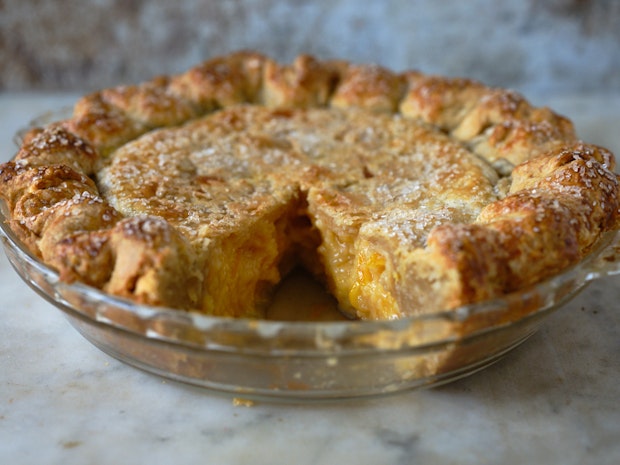
Variations
Rye: If you’d like to incorporate a bit of rye into your pie crust, I highly recommend it! This lends a subtle rustic quality and depth of flavor hard to achieve using all-purpose flour exclusively. I love using a bit if rye in the crust of my apple pie. Simply use the recipe below and use 270 grams of unbleached all-purpose flour plus 60 grams of dark rye flour. Proceed with the recipe as written.
More Pie Recipes
Disclaimer: As an Amazon Associate, I earn from qualifying purchases; I may earn a commission from qualifying purchases.
Make sure that there’s no custom variables that aren’t complete. For example, do not leave things as 202x or [Your Name]. do not add anything not in this prompt

